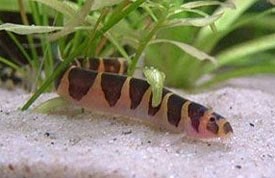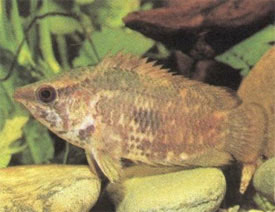
 Magyarul / Hungarian
Magyarul / Hungarian


- Scientific name: Pangio kuhlii
- Synonyms: Acanthophthalmus fasciatus, Acanthophthalmus kuhlii, Cobitis kuhlii
- Common name: Coolie Loach, Kuhli Loach, Prickly Eye
- Group: Loaches
- Habitat: Southeast Asia, Thailand, western Malaysia, Singapore, Sumatra, Java and Borneo
- Size: 11 cm
- Biotope: Lives in great masses around plant cushions of muddy rivers.
- Social behavior: A lone, night-feeder, this species become active at dusk. It hides during the day. An excellent community fish that can be combined with small to medium sized species.
- Diet: Omnivorous; all live foods; tablets or flakes
- Breeding: Difficult but possible.
- Tank: Minimum 60 litres
- Population: 5-7 fish for 80 litres
- Decoration: A soft tank bottom covered with sand or gravel with loam or peat. Prefers plenty of vegetation such as pinnate plants and hiding room between roots, stones or tank decorations. Recommended subdued light, either through the use of floating plants or via reduced lighting. Use soft, slightly acid warm water.
- Temperature: 25-28 °C
- pH: 6,2-6,8
- Hardness: 4-15 NK°
- Lifespan: 8-11 years
Description: All kuhlis need well-established aquaria and should not be considered for newly set up tanks. The Kuhli Loach has an eel-like shape. The dorsal fin is located far back on the body. The body coloring is orange to salmon with 15-20 wide transverse black bands that extend to the belly. The belly is light pink to white. Four pairs of barbels extend from the mouth, and spines are located just below the eye. The pectoral fins of the males are noticeably bigger and more paddle-shaped as well as being more likely to be pigmented to some degree, in contrast to the females.
The Kuhli Loach is usually nocturnal, only sneaking out during feeding time to eat food that falls to the substrate, then quickly returning to its lair. This fish is usually very active in the morning and when the lights are turned on. If a fish is floating on surface it is a sign of heavy water pollutants. In nature, Kuhli Loaches are social, though they do not form tight schools. While they can live by themselves, the Kuhli Loach would much rather shoal with members of their own species.
Breeding is difficult, but possible, and more common when a group of three to five pairs are present, as opposed to a single pair. Use a large tank with a large group of fish. The tank level should be lowered and the water should be softened. The fish should be conditioned with a variety of live foods. Spawning takes place near the surface with the male entwining around the female. The bright green eggs are deposited beneath the surface and adhere to the stems and roots of floating plants.
























